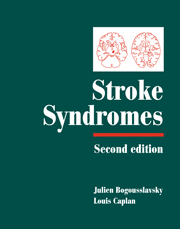Book contents
- Frontmatter
- Contents
- List of contributors
- Preface
- PART I CLINICAL MANIFESTATIONS
- PART II VASCULAR TOPOGRAPHIC SYNDROMES
- 29 Arterial territories of human brain
- 30 Superficial middle cerebral artery syndromes
- 31 Lenticulostriate arteries
- 32 Anterior cerebral artery
- 33 Anterior choroidal artery territory infarcts
- 34 Thalamic infarcts and hemorrhages
- 35 Caudate infarcts and hemorrhages
- 36 Posterior cerebral artery
- 37 Large and panhemispheric infarcts
- 38 Multiple, multilevel and bihemispheric infarcts
- 39 Midbrain infarcts
- 40 Pontine infarcts and hemorrhages
- 41 Medullary infarcts and hemorrhages
- 42 Cerebellar stroke syndromes
- 43 Extended infarcts in the posterior circulation (brainstem/cerebellum)
- 44 Border zone infarcts
- 45 Classical lacunar syndromes
- 46 Putaminal hemorrhages
- 47 Lobar hemorrhages
- 48 Intraventricular hemorrhages
- 49 Subarachnoid hemorrhage syndromes
- 50 Brain venous thrombosis syndromes
- 51 Carotid occlusion syndromes
- 52 Cervical artery dissection syndromes
- 53 Syndromes related to large artery thromboembolism within the vertebrobasilar system
- 54 Spinal stroke syndromes
- Index
- Plate section
30 - Superficial middle cerebral artery syndromes
from PART II - VASCULAR TOPOGRAPHIC SYNDROMES
Published online by Cambridge University Press: 17 May 2010
- Frontmatter
- Contents
- List of contributors
- Preface
- PART I CLINICAL MANIFESTATIONS
- PART II VASCULAR TOPOGRAPHIC SYNDROMES
- 29 Arterial territories of human brain
- 30 Superficial middle cerebral artery syndromes
- 31 Lenticulostriate arteries
- 32 Anterior cerebral artery
- 33 Anterior choroidal artery territory infarcts
- 34 Thalamic infarcts and hemorrhages
- 35 Caudate infarcts and hemorrhages
- 36 Posterior cerebral artery
- 37 Large and panhemispheric infarcts
- 38 Multiple, multilevel and bihemispheric infarcts
- 39 Midbrain infarcts
- 40 Pontine infarcts and hemorrhages
- 41 Medullary infarcts and hemorrhages
- 42 Cerebellar stroke syndromes
- 43 Extended infarcts in the posterior circulation (brainstem/cerebellum)
- 44 Border zone infarcts
- 45 Classical lacunar syndromes
- 46 Putaminal hemorrhages
- 47 Lobar hemorrhages
- 48 Intraventricular hemorrhages
- 49 Subarachnoid hemorrhage syndromes
- 50 Brain venous thrombosis syndromes
- 51 Carotid occlusion syndromes
- 52 Cervical artery dissection syndromes
- 53 Syndromes related to large artery thromboembolism within the vertebrobasilar system
- 54 Spinal stroke syndromes
- Index
- Plate section
Summary
Introduction
The middle cerebral artery (MCA) and its branches are the most commonly affected brain vessels in cerebral infarction. The MCA territory was involved in more than twothirds of all cerebral infarcts in 891 patients with first stroke in the Lausanne Stroke Registry; the remainder affecting the posterior circulation (26%), and more rarely the anterior cerebral artery (2%). Among MCA infarcts, the superficial MCA territory was involved in more than half the patients, the deep MCA territory in one-third and the deep plus superficial MCA territory in one-tenth (Bogousslavsky et al., 1988a).
Superficial MCA territory infarcts can be large when the occlusion of the MCA trunk is proximal, at the level of the bior trifurcation just after the origin of the lenticulostriate arteries, mainly in the absence of an efficient collateral system. However, superficial MCA territory infarcts can also be partial if a distal branch is occluded (Bogousslavsky, 1991b). In the Lausanne Stroke Registry, superficial MCA infarct was observed in nearly one-third of all first strokes, and in more than half the carotid territory infarcts (anterior superficial in 31%; posterior superficial in 20%) (Bogousslavsky et al., 1988a). Completesuperficial territory infarcts may occur in 3% of the patients, whereas upper division and lower division MCA infarcts occur, respectively, in 18% and 14% (Bogousslavsky, 1991b), especiallyon the left side (Bogousslavsky et al., 1989;Mohr et al., 1978).
Because most of the frontal, temporal, and parietal lobes are supplied by MCA pial branches, the neurologic picture is highly variable and follows the location of infarct. A few clinical syndromes are strongly suggestive of a MCA branch territory infarct, which can be recognized before CT or MRI.
- Type
- Chapter
- Information
- Stroke Syndromes , pp. 405 - 427Publisher: Cambridge University PressPrint publication year: 2001
- 5
- Cited by



